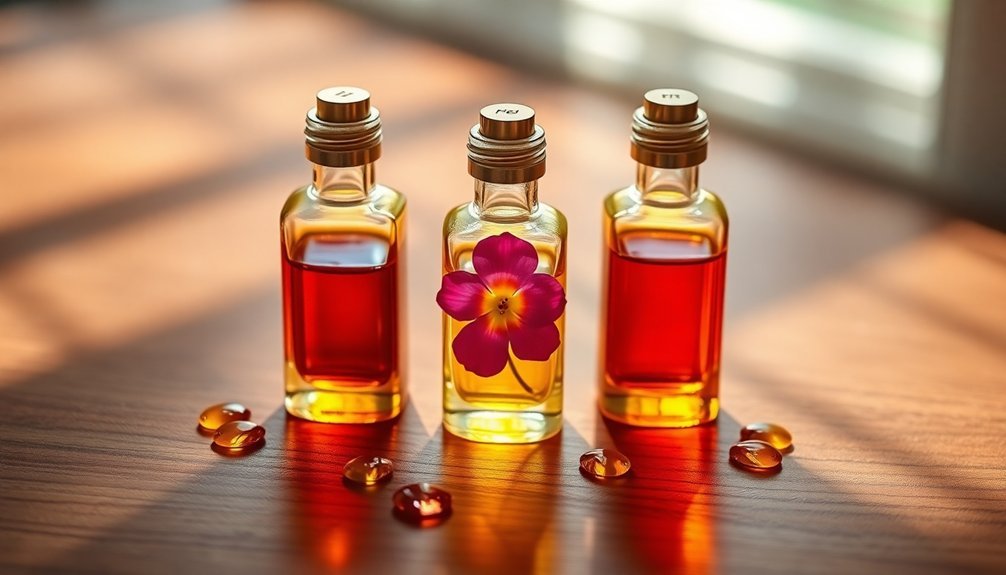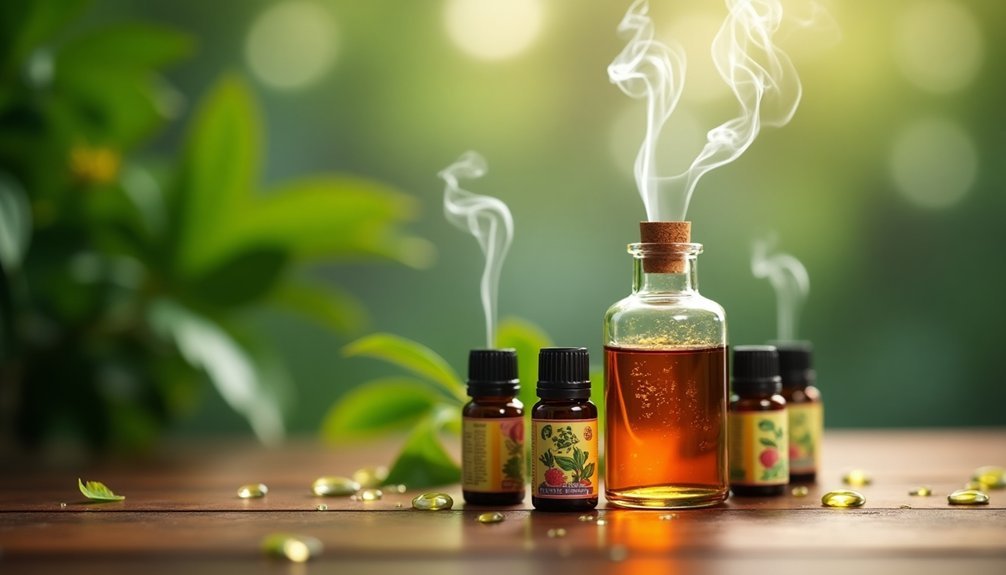Three proven perfume oil ratios will help you create beautiful fragrances. Start with the classic 30-50-20 formula (30% top notes, 50% middle notes, 20% base notes) for a well-balanced scent. For skin safety, follow the 20% essential oil rule by mixing 20% oils with 80% carrier oil. If you prefer lighter scents, try the 1:10 ratio of fragrance to carrier oil. These fundamental ratios reveal endless possibilities for your perfect signature scent.
Classic 30-50-20 Perfume Oil Formula

Three fundamental components create the time-tested 30-50-20 perfume oil formula: top notes at 30%, middle notes at 50%, and base notes at 20%.
You'll find this ratio crucial for crafting well-balanced fragrances that evolve beautifully over time.
When creating a 20-drop blend, you'll need 6 drops of top notes (like bergamot or lemon) for the initial fresh impression, 10 drops of middle notes (such as lavender or geranium) for the heart of your fragrance, and 4 drops of base notes (like cedarwood or frankincense) to ground the scent.
Start by adding your base notes first, followed by middle notes, and finish with top notes. You can combine multiple oils within each category while maintaining these proportions. Allow your blend to rest for 48 hours before making a final assessment of the fragrance.
Test your blend on fragrance strips to verify it meets your desired outcome.
Skin-Safe 20% Essential Oil Balance
While the classic 30-50-20 formula guides note proportions, safe skin application requires a different approach.
You'll need to maintain a strict 20% essential oil to 80% carrier agent ratio to protect your skin. For a 50ml blend, this means using 10ml (about 200 drops) of essential oils with 40ml of carrier agent like perfumer's alcohol or fractionated coconut oil.
If you have sensitive skin, reduce the essential oil content to 15%. Always perform a 48-hour patch test before applying any new blend. Starting with one or two oils will help you identify any potential skin reactions more easily.
Choose 100% pure oils from reputable vendors, and keep detailed records of each oil's botanical name and origin.
Let your blend rest for 48 hours to allow the scents to meld properly, and store it in dark glass bottles away from light and heat.
Light Fragrance 1:10 Carrier Blend

Creating a light fragrance starts with the fundamental 1:10 ratio – one part fragrance oil to ten parts carrier oil. For example, blend 10ml of fragrance oil with 100ml of carrier oil like jojoba, sweet almond, or fractionated coconut oil. This ratio guarantees a safe, skin-friendly perfume while maintaining a delicate scent profile. When selecting oils, consider starting with base notes for a long-lasting foundation.
- Use clean pipettes for precise measurements and avoid contamination.
- Store your blend in a dark glass container for 48 hours to 1 month.
- Test the perfume on a small patch of skin after aging.
- Adjust the ratio between 1:5 and 1:20 based on desired strength.
- Label your bottle with ingredients and creation date.
You can experiment with multiple fragrance oils to create unique combinations, but always maintain the proper dilution ratio to prevent skin irritation.
Frequently Asked Questions
How Long Does a Homemade Perfume Oil Blend Typically Last Before Expiring?
Your homemade perfume oil blend will typically last 1-2 years when you've stored it properly. You'll get even longer shelf life if you're using high-quality ingredients and maintaining proper storage conditions.
Can I Mix Different Carrier Oils Together in One Perfume Blend?
Yes, you can mix different carrier oils together in your perfume blend. It's a great way to customize viscosity and properties. You'll want to combine them first before adding your essential oils.
What's the Best Container Material for Storing Perfume Oil Blends?
You'll want to store your perfume oil blends in dark glass bottles, preferably amber or cobalt. They'll protect against UV rays and won't react with your oils like plastic containers can. Always guarantee airtight seals.
How Often Should I Shake or Mix My Perfume Oil Blend?
You'll want to shake your perfume oil blend daily during the first week of maturation, then every few days afterward. Always give it a gentle shake before each use to maintain consistent scent distribution.
Can Weather or Temperature Affect the Scent of My Perfume Blend?
Yes, your perfume blend's scent changes with weather conditions. Heat makes it stronger but fade faster, while cold weather brings out base notes. Humidity affects longevity too – it'll last longer in moist air.
In Summary
Experimenting with these three proven ratios will help you create your signature scents confidently. Whether you choose the classic 30-50-20 formula, the gentle 20% essential oil blend, or the light 1:10 carrier mix, you'll have reliable starting points for your perfume-making journey. Remember to take detailed notes of your successful combinations, and don't be afraid to make subtle adjustments to suit your preferences.





Leave a Reply